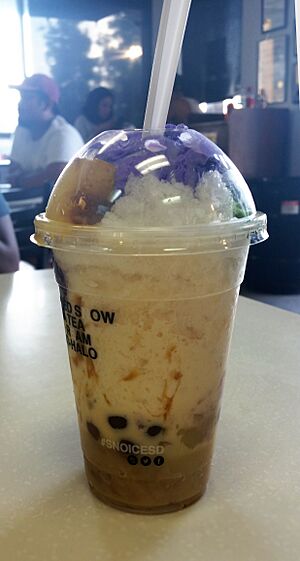Halo-halo facts for kids

A bowl of halo-halo
|
|
| Course | Dessert |
|---|---|
| Place of origin | Philippines |
| Main ingredients | Shaved ice, milk, various fruits |

Halo-halo is a super popular cold dessert from the Philippines. Its name means "mixed" in Tagalog, which makes sense because you mix it all up before you eat it!
This yummy treat is made with crushed ice and evaporated milk or coconut milk. Then, lots of different ingredients are added. These can include sweet purple yam jam (called ube halaya), sweetened kidney beans or garbanzo beans, coconut strips, and sago (small chewy balls). You might also find gulaman (jelly made from agar), crispy pinipig (pounded rice), boiled taro or yams, and creamy flan.
Often, a scoop of purple yam ice cream sits on top. Halo-halo is usually served in a tall, clear glass with a long spoon. Many people think it's the unofficial national dessert of the Philippines!
Contents
Where Did Halo-halo Come From?
The idea for halo-halo actually started with Japanese people living in the Philippines before World War II. They had a similar dessert called kakigōri, which is also made with shaved ice.
One of the first versions of halo-halo was called monggo kon-yelo. It had mung beans (monggo) cooked in syrup, served over crushed ice with milk and sugar. Over time, more local Filipino ingredients were added, and that's how the modern halo-halo we know today was created.
A cool difference is that in halo-halo, many ingredients are placed *under* the ice, not just on top like in some Japanese desserts. You can still find simple versions today, like mais kon-yelo (with sweet corn) or saba kon-yelo (with saba bananas).
Some people believe halo-halo became popular in the 1920s or 1930s. This was thanks to Japanese people near the Quinta Market in Quiapo, Manila. This area was close to the Insular Ice Plant, which was the main place to get ice in the Philippines. The Americans built this ice plant in 1902. Even before that, ice was brought to the Philippines from places like Wenham Lake in the United States in the mid-1800s.
The official spelling for the dessert, according to the Commission on the Filipino Language, is actually haluhalo. This is because haluhalo is a Tagalog adjective that means "mixed together."
What's Inside a Halo-halo?
There isn't one exact recipe for halo-halo. The ingredients can change a lot, but some common ones include sweet sugar palm fruit (kaong) and coconut sport (macapuno). You might also find saba plantains cooked in syrup (minatamis na saging), jackfruit (langkâ), and different jellies like gulaman and nata de coco.
Other tasty additions are tapioca pearls, sweet sweet potato (kamote), sweetened beans, and even cheese! Crispy pinipig (toasted young rice) is often sprinkled on top.
The ingredients are usually layered. The fruits, beans, and other sweets go at the bottom. Then comes the shaved ice. On top, you'll often find a mix of leche flan, ube halaya (mashed purple yam), or ice cream. Just before you eat it, Evaporated milk or coconut milk is poured over everything.
Across the Philippines, you can find many different kinds of halo-halo. Some places add sweetened wintermelon, durian, or even strawberry ice cream!
A similar dessert from the Visayas region is called binignit. It's sometimes called "ginataang halo-halo" in Tagalog, which means "halo-halo in coconut milk." It uses many of the same ingredients, but binignit is usually served hot.
Halo-halo in Pop Culture
Halo-halo has been shown on popular TV shows!
In the TV series Anthony Bourdain: Parts Unknown, the host Anthony Bourdain tried halo-halo at a Jollibee fast-food restaurant in Los Angeles. He really liked it and called it "oddly beautiful." He even shared a picture of the dessert on his Twitter account. Later, in another episode, he learned how Filipinos make this special dessert.
The dessert was also a challenge dish on the American cooking show Top Chef. Filipino-American contestant Dale Talde made halo-halo with avocado, mango, kiwifruit, and nuts. His dish was chosen as one of the top three by the guest judge!
Halo-halo was also featured on an episode of Bizarre Foods that explored delicious destinations.
You can find halo-halo almost everywhere in the Philippines, from small food stands to fancy 5-star hotels. Popular Filipino fast-food chains like Jollibee, Max's, and Chowking all serve this amazing dessert.
See also
 In Spanish: Halo-halo para niños
In Spanish: Halo-halo para niños


